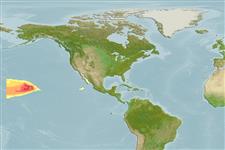Classification / Names
Common names | Synonyms | Catalog of Fishes(genus, species) | ITIS | CoL | WoRMS | Cloffa
Teleostei (teleosts) >
Lophiiformes (Anglerfishes) >
Linophrynidae (Leftvents)
Etymology: Linophryne: Greek, 'linon' = flax or anything made of flax such as "cord," "rope," or a "net" + Greek, 'phryne' = "toad" (refers to a toadlike fish that fishes with a net) (Ref. 86949); escaramosa: Named in reference to its highly branched escal filaments (Ref. 42949).
Environment: milieu / climate zone / depth range / distribution range
Ecology
Marine; bathypelagic; depth range 0 - 1350 m (Ref. 86949). Deep-water
Eastern Central Pacific: known only from off Oahu, Hawaiian Islands.
Size / Weight / Age
Maturity: Lm ? range ? - ? cm
Max length : 3.7 cm SL (female)
Short description
Identification keys | Morphology | Morphometrics
Dorsal soft rays (total): 3; Anal soft rays: 3. Female esca with oblong, distal prolongation of bulb, as long as diameter of escal photophore, with internal (light-guiding) structure bifurcated at tip and bearing branched, distal filaments; series of 6-7, long, branched filaments on each side of bulb, the proximalmost emerging from base of escal bulb; small conical, posterior appendage behind escal pore. Dense concentration of subdermal pigment on caudal peduncle (Ref. 42949).
Males unknown (Ref. 42949).
Life cycle and mating behavior
Maturity | Reproduction | Spawning | Eggs | Fecundity | Larvae
Bertelsen, E., 1982. Notes on Linophrynidae VIII. A review of the genus Linophryne, with new records and descriptions of two new species. Steenstrupia 8(3):49-104. (Ref. 42949)
IUCN Red List Status (Ref. 130435: Version 2024-2)
Threat to humans
Harmless
Human uses
Tools
Special reports
Download XML
Internet sources
Estimates based on models
Preferred temperature (Ref.
123201): 5.7 - 15.2, mean 8.7 °C (based on 5 cells).
Phylogenetic diversity index (Ref.
82804): PD
50 = 0.5000 [Uniqueness, from 0.5 = low to 2.0 = high].
Bayesian length-weight: a=0.01995 (0.00906 - 0.04395), b=3.01 (2.83 - 3.19), in cm total length, based on all LWR estimates for this body shape (Ref.
93245).
Trophic level (Ref.
69278): 3.3 ±0.6 se; based on size and trophs of closest relatives
Fishing Vulnerability (Ref.
59153): Low vulnerability (10 of 100).
